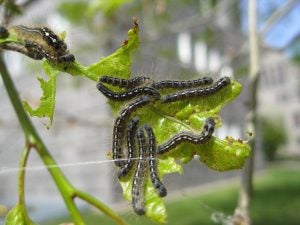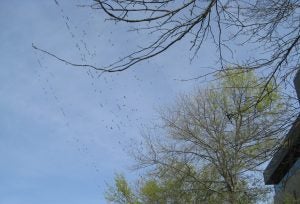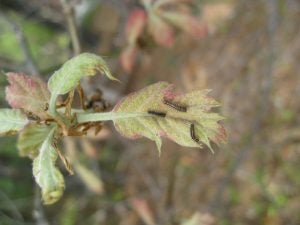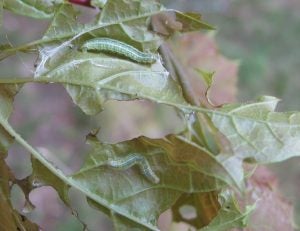Caterpillar update 5/17/17
Caterpillar update May 17, 2017
Are you seeing trees or shrubs defoliated by caterpillars now? If so, these caterpillars are probably forest tent caterpillars (not to be confused with Eastern tent caterpillars that make obvious tents). At URI several oak and cherry trees have been defoliated by forest tent caterpillars this week. Last year forest tent caterpillars defoliated many trees in Richmond, Charlestown, Exeter, and Coventry.


Forest tent caterpillars feeding on oak. Forest tent caterpillars leaving defoliated oak.
Forest tent caterpillars form a silken mat where caterpillars tend to congregate, though usually the silken mat is not visible. If you find forest tent caterpillars I’d like to know where you are seeing them. Please send me an email at hhf@uri.edu
Forest tent caterpillars and Eastern tent caterpillars hatched about 2 weeks before gypsy moths, so tent caterpillars are much larger than gypsy moth caterpillars now.

Gypsy moth caterpillars still small.
Everyone is wondering if we have had sufficient wet weather to spread the two diseases that kill gypsy moth caterpillars. The wet weather we’ve been experiencing is terrific for spreading caterpillar diseases, but we need additional wet weather during the rest of the month and through June. We need normal, spring weather – not droughty conditions. It takes time for the fungal and viral inoculum to build up and spread throughout the gypsy moth population. Most gypsy moth caterpillars don’t die from diseases until they are full-grown caterpillars and after they have done a lot of feeding.
If you are considering spraying a few trees or shrubs, gypsy moth caterpillars are still small enough to be controlled with a Bt insecticide such as DiPel or Thuricide. In another week or so they may be too large to be controlled with Bt. Once gypsy moth caterpillars are large, a spinosad insecticide such as Conserve (commercial), Delegate (commercial fruit production), or Captain Jack’s Deadbug Brew (non-commercial plant grower) is needed to control gypsy moths. Bt insecticides kill caterpillars and not other insects, therefore it is safe to apply to blooming plants. Spinosad will kill bees for several hours after application so do not apply to plants in bloom.
Spinosad should also be effective against forest tent caterpillars now, but with forest tent caterpillars, by the time you see them it is usually too late. You may want to protect nearby tree as forest tent caterpillars migrate to new trees.
The few winter moth caterpillars around are mostly full grown caterpillars and nearly ready to drop to the soil and pupate. There has been very little damage from winter moth caterpillars this spring. So there, ending on a happy note!

Mature winter moth caterpillars nearly ready to drop to ground.
 Home
Home Browse
Browse Close
Close Events
Events Maps
Maps Email
Email Brightspace
Brightspace eCampus
eCampus


